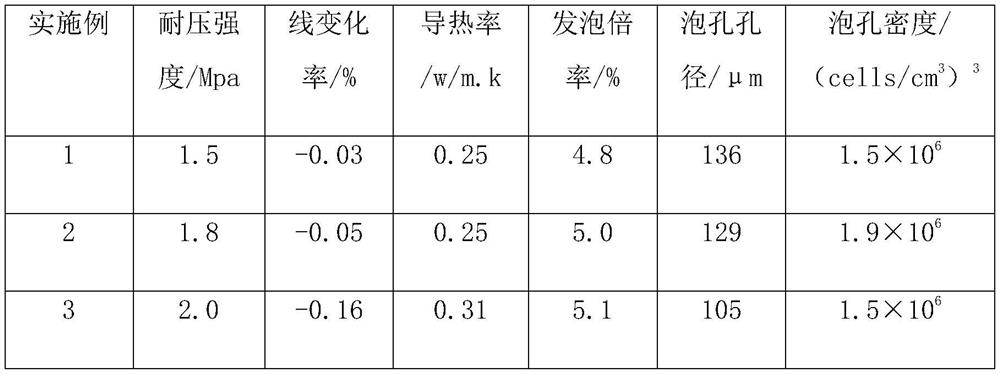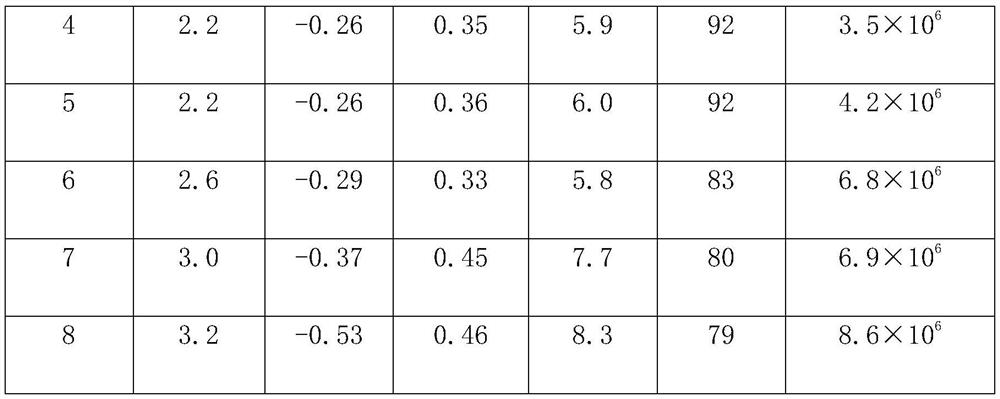Method for preparing light PET composite foam material by utilizing melt-blowing technology
A composite foaming and melt-blown technology, applied in the field of composite foaming materials, can solve the problems of low molecular weight of PET foaming materials, difficult to withstand the tensile stress of bubbles, cell rupture, collapse, merger, etc., and achieve high foaming rate. , The effect of uniform cells and high foaming ratio
- Summary
- Abstract
- Description
- Claims
- Application Information
AI Technical Summary
Problems solved by technology
Method used
Image
Examples
Embodiment 1
[0024] Embodiment 1: a kind of method utilizing melt-blown technology to prepare lightweight PET composite foaming material, comprises the following steps:
[0025] S1, ingredients;
[0026] Weigh respectively by weight: 18 parts of PET resin, 6 parts of SG-2 polyvinyl chloride resin, 5 parts of wood flour, 4 parts of EPDM rubber, 3 parts of hydroxymethyl cellulose, 2 parts of polylactic acid, and 1 part of nucleating agent, 0.5 part of dispersing agent, 1 part of flame retardant, and 3 parts of foaming agent; wherein, the nucleating agent is calcium carbonate solution, the dispersing agent is methyl amyl alcohol, the flame retardant is aluminum hydroxide aqueous solution, foaming agent The foaming agent is azodicarbonamide;
[0027] S2, raw material modification;
[0028] Put the PET resin, SG-2 polyvinyl chloride resin, wood powder, EPDM rubber, hydroxymethylcellulose and polylactic acid obtained in step S1 into the reaction kettle, and react at 235°C for 0.5h; after the r...
Embodiment 2
[0033] Embodiment 2: a kind of method utilizing melt-blown technology to prepare lightweight PET composite foaming material, comprises the following steps:
[0034] S1, ingredients;
[0035] Weighed in parts by weight: 23 parts of PET resin, 19 parts of SG-2 polyvinyl chloride resin, 113 parts of wood flour, 7 parts of EPDM rubber, 5 parts of hydroxymethyl cellulose, 6 parts of polylactic acid, and 2 parts of nucleating agent, 1.8 parts of dispersing agent, 2 parts of flame retardant, 6 parts of foaming agent; wherein, nucleating agent is calcium carbonate solution, dispersing agent is methyl amyl alcohol, flame retardant is aluminum hydroxide aqueous solution, foaming agent The foaming agent is azodicarbonamide;
[0036] S2, raw material modification;
[0037]First, PET resin, SG-2 polyvinyl chloride resin, wood powder, EPDM rubber, hydroxymethyl cellulose and polylactic acid are mixed evenly, and the mixed material is preheated to 160°C and then added to the screw extruder...
Embodiment 3
[0042] Embodiment 3: a kind of method utilizing melt-blown technology to prepare lightweight PET composite foaming material, comprises the following steps:
[0043] S1, ingredients;
[0044] Weighed in parts by weight: 45 parts of PET resin, 27 parts of SG-2 polyvinyl chloride resin, 13 parts of wood flour, 9 parts of EPDM rubber, 6 parts of hydroxymethyl cellulose, 9 parts of polylactic acid, and 3 parts of nucleating agent, 0.5 part of dispersing agent, 3 parts of flame retardant, 8 parts of foaming agent; wherein, nucleating agent is calcium carbonate solution, dispersing agent is methyl amyl alcohol, flame retardant is aluminum hydroxide aqueous solution, foaming agent The foaming agent is azodicarbonamide;
[0045] S2, raw material modification;
[0046] First, PET resin, SG-2 polyvinyl chloride resin, wood flour, EPDM rubber, hydroxymethyl cellulose and polylactic acid are mixed evenly, and the mixed material is preheated to 290°C and then added to a screw extruder to ...
PUM
| Property | Measurement | Unit |
|---|---|---|
| melt flow index | aaaaa | aaaaa |
| melt flow index | aaaaa | aaaaa |
| melt flow index | aaaaa | aaaaa |
Abstract
Description
Claims
Application Information
 Login to View More
Login to View More - R&D
- Intellectual Property
- Life Sciences
- Materials
- Tech Scout
- Unparalleled Data Quality
- Higher Quality Content
- 60% Fewer Hallucinations
Browse by: Latest US Patents, China's latest patents, Technical Efficacy Thesaurus, Application Domain, Technology Topic, Popular Technical Reports.
© 2025 PatSnap. All rights reserved.Legal|Privacy policy|Modern Slavery Act Transparency Statement|Sitemap|About US| Contact US: help@patsnap.com


